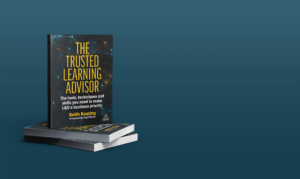5 Ways to Sharpen Your L&D Practitioner Skills
-
 Keith Keating
Keith Keating
- August 19, 2021
Skills, skills, skills. Many of us are talking about the importance of skills and if you are not talking about the importance of skills — you should be! When we talk about skills or skill gaps in the learning and development (L&D) industry, we are often talking about someone else’s skill gaps. Rarely, if ever, have I heard an L&D practitioner talking about their own skill gaps. But when it comes to skills gaps, here’s the catch: They are not only present in our learners.
We, as L&D practitioners, can develop skills gaps of our own. After all, as technology, business and learners evolve, why wouldn’t we also need to evolve? Often, we spend so much time training others that we forget the importance of continuing to develop our own skills.
Before advocating for learners to develop skills, ask yourself: What have I done recently to develop my skills as an L&D practitioner? How am I staying relevant and educated? Here is how I equate it: Let’s say you trained for and ran one marathon in 1989. Assuming you stopped training after running your one marathon, you would not be qualified to call yourself a marathon runner today.
Anyone can label themselves an L&D practitioner. The challenge, however, is that not everyone is an actual practitioner. A practitioner is someone who is qualified and actively engaged in their field of work. Being “qualified” in the L&D industry can be subjective. Although certifications and standardizations exist, they are not required. And active engagement is more than simply “doing your job.” In L&D, active engagement means investing time and understanding into the academic and theoretical side of learning — not just the application of it. It means focusing on learning frameworks, theories, and strategies on an ongoing basis to ensure your training is grounded in research-based methodologies.
Many L&D practitioners are well-versed in their area of focus but are often siloed and not connected to the underlying principles of L&D.
Here are five ways to sharpen your L&D practitioner skills:
1. Understand Learning Theories
In order to be a practitioner in an area of work, the underlined theories that support the practice should be understood. If you consider yourself an L&D practitioner, that means that you are also a learning theorist and you understand the associated theories.
Learning theories are frameworks that provide an understanding of the different ways that learners receive, process and retain knowledge during the learning process. Cognitive, behaviorism and constructivism are the three most commonly-referred to learning theories.
If you do not know who Piaget is or what the behaviorist learning theory is, you have some homework to do. Although it is important to be familiar with current learning theories or practitioners, such as Bob Mosher, Clark Quinn and Nigel Paine, it is also important to be familiar with those who came before, such as B.F. Skinner, Edward Thorndike and Hermann Ebbinhaus (Ebbinhaus’s Forgetting Curve is an important theory establishing credibility for the need of spaced learning). When we are creating learning solutions and trying to drive behavior changes, it is important to have an understanding of learning theories and which one (or ones) your learning solution falls within. Understanding learning theories will strengthen your ability to provide the right solution to your learners and establish your credibility as a practitioner.
2. Research, Research, Research
Empower yourself with research. Research helps to provide a basis to inform action, gather evidence for theories, provide and a deeper understanding of why, and answer questions. If you are not sure where to start, consider diving into the following research topics:
- The latest learning trends.
- The history of learning.
- The future of learning.
- The science of learning.
- Learning theories.
Skip the basic Google searches and go straight to Google Scholar to find empirical research from accredited academic institutions and industry journals. Look for research that not only has been cited but also has citations and follow the citation breadcrumb trail to find the original data source.
Leverage free industry research from reputable firms like McKinsey Global Institute and the World Economic Forum. Our role as learning practitioners is to research and curate findings to apply in the context of our learners.
3. Be a Critical Thinker by Asking Questions
When it comes to filling your L&D solution toolbox, reading articles and evaluating what’s new in the industry can sharpen your critical thinking skills. Start by asking “why?”. Challenge industry trends. For instance, don’t assume that because everyone is talking about a new technology trend, for example learning experience platforms (LXPs), that LXPs must be something you need in your organization. Often, we tend to suffer from groupthink. We assume that someone else is doing “learning” better and set off on a quest to find that silver bullet, that solution to solve all our problems. However, learning is not a one-size-fits-all solution. Be wary of trends and buzzwords used to grab our attention, promising to solve all our problems. Look for the evidence because, often, you will find solutions by understanding your learners.
4. Understand the Principles of Human-centered Design
Our learners come first, no matter what. Everything we do in L&D is for our learners; our purpose is to be advocates for the learners. This means we need to stay connected to and understand our learners; this means including learners as one of our primary stakeholders. Human-centered design is an approach that provides frameworks and tools to ensure we keep the human at the forefront of our problem-solving process. Three frameworks within the human-centered design family can be particularly useful for ensuring we are developing solutions with our learners in mind: design thinking, user experience (UX) design and the learner experience (LX).
5. Give Back to the L&D Community
In the words of Michio Kaku, “Knowledge is useless if you do not share it.” Whether you recognize this or not, your experience and knowledge is what keeps our industry growing and evolving. How you apply L&D principles and practices are valuable to others.
Rarely are two learning organizations exactly alike. The more we share our unique experiences, the more empowered and enabled we are as practitioners to support our learners. Share your knowledge and your experience with others by:
- Writing a blog or an article.
- Hosting a webinar on an L&D topic you are passionate about or where you see a gap exists in the industry.
- Getting involved in industry associations.
Lifelong learning is not something we want just for our learners; we, as L&D practitioners, also need to be lifelong learners. Being a practitioner takes work but, as a result of that work, you will be rewarded with a stronger solutions toolkit, credibility and the honor of calling yourself a L&D practitioner.




